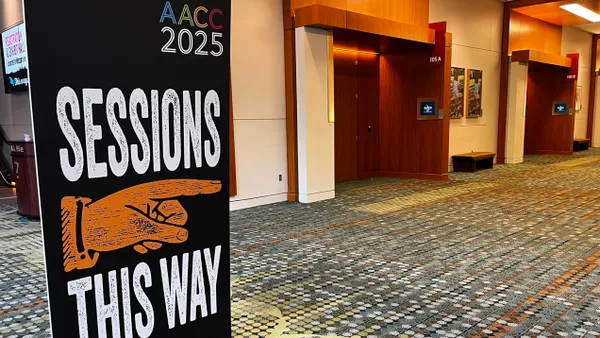Dive Brief:
- First-year students who have a history of psychiatric hospitalization and reported high levels of academic distress are 48% more likely than others to withdraw from college while receiving counseling services, according to a report from Penn State University's Center for Collegiate Mental Health.
- But several factors are associated with students staying in college. Students were 51% less likely to withdraw from college if they participated in an extracurricular activity and experienced decreasing academic distress during counseling.
- “Our data shows there are a wide range of factors — both mental health and non-mental health related — that impact the risk of dropping out of school while receiving counseling services,” Brett Scofield, executive director of the Center for Collegiate Mental Health, said in a statement. “Therefore, it is essential for institutions to assess and strengthen their local offerings of mental health, academic, social and cultural support services that ultimately support the academic mission.”
Dive Insight:
Counseling centers serve a critical role in supporting colleges' academic mission. They routinely work with students experiencing a diverse array of complex issues, according to the new report, which is the latest version of an annual publication of data about college students who receive counseling center services.
The report collected data from 180 college counseling centers and 4,688 clinicians. It covers almost 191,000 college students seeking mental health treatment.
Students are more likely to stay enrolled when they improve during counseling services. But previous reports from the Center for Collegiate Mental Health found that larger counselor caseloads were associated with less improvement in symptoms.
Several factors are associated with students dropping out at higher rates. Among students in counseling with academic distress, 4% withdrew from classes in the 2021-2022 school year. Overall distress was associated with a similar dropout rate of 3.9%. Depression was tied to a 3.5% dropout rate, while social anxiety was associated with a dropout rate of 3.2%.
Those compare to an average dropout rate of 2.8%.
The report found some fluctuation in the prevalence of the stressors reported by students. In 2021-2022, academic distress among counseled students declined slightly from the previous academic year, but it continued to be more prevalent than it was prior to the COVID-19 pandemic.
Anxiety remained a top stressor, with 24.6% of therapists listing it as the primary concern for patients. Social anxiety surpassed generalized anxiety as a risk factor for dropping out.














